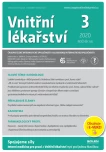Cardiac involvement in hypereosinophilia
Authors:
Lenka Roblová; Petr Kuchynka; Jan Kuchař; Tomáš Paleček
Authors‘ workplace:
II. interní klinika – klinika kardiologie a angiologie 1. LF UK a VFN Praha
Published in:
Vnitř Lék 2020; 66(3): 44-49
Category:
Overview
Cardiac abnormalities associated with hypereosinophilia represent rare diseases and occurs most commonly due to hypersensitivity or allergic reactions, other possible etiologies cover infections, malignancy, vasculitis or hypereosinophilic syndromes. Three stages of cardiac involvement are usually described. Initially, myocardial inflammation occurs, that can continue with a thrombotic stage and eventually progress to the last irreversible stage called endomyocardial fibrosis, which represents one of the acquired forms of restrictive cardiomyopathy. In most patients, increased levels of eosinophils in the blood differential test; however, it may not be present in the initial stages of the disease. Of the imaging methods, magnetic resonance imaging and positron emission tomography combined with CT PET-CT are used in addition to echocardiography. Endomyocardial biopsy may be indicated for definitive evidence of eosinophilic myocarditis. The clarification of the cause of hypereosinophilia is necessary for specific treatment of this disorder.
Keywords:
endomyocardial fibrosis – eosinophilic myocarditis – hypereosinophilia – restrictive cardiomyopathy
Sources
1. Gotlib J. World Health Organization‑defined eosinophilic disorders: 2014 update on diagnosis, risk stratifacation and management. American Journal of Hematology 2014; 89: 325–337.
2. Löffler W. Endokarditis parietalis fibroplastica mit bluteosinphilie. Ein eigenartiges Krankheitsbild. Schweiz Med Wochenschr 1936; 66: 817–820.
3. Kuchynka P, Paleček T, Mašek M, et al. Current diagnostic and therapeutic aspects of eosinophilic myocarditis. Biomed Res Int 2016; Article ID 2829583.
4. Al Ali AM, Straatman LP, Allard LF, et al. Eosinophillic myocarditis: case series and review of literature. Canadian Journal of Cardiology 2006; 22: 1233–1237.
5. Marijon E Aspects of a neglected tropical cardiomyopathy: endomyocardial fibrosis. Arch Cardiovasc Dis 2008; 101: 801–802.
6. Takkenberg JJM, Czer L, Fishbein M, et al. Eosinophilic myocarditis in patients awaiting heart transplantation. Critical Care Medicine 2004; 32: 714–721.
7. Ball JK, Williams AW, Davies JN. Endomyocardial fibrosis. Lancet 1954; 266: 1049–1054.
8. Yoshizawa S, Kato T, Mancini D, et al. Characteristics of patients with advanced he‑ art failure having eosinophilic infiltration of the myocardium in the recent era: investigation of explanted hearts for transplantation. International Heart Journal 2013; 54: 146–148.
9. Oakley C, Olsen E. Eosinophilia and heart disease. British Heart Journal 1977; 39: 233–237.
10. Cugno M, Marzano A, Lorini M, et al. Enhanced tissue factor expression by blood eosinophils from patients with hypereosinophilia: a possible link with thrombosis. PLoS ONE 2014; 9: Article ID e111862.
11. Seguea P, Iriart S, Acar P, et al. Eosinophilic cardiac disease: molecular, clinical and imaging aspects. Archives of Cardiovascular Diseases 2015; 108: 258–268.
12. Akuthota P, Weller P. Spectrum of eosinophilic endorgan manifestations. Immunology and Allergy Clinics of North America 2015; 35: 403–411.
13. Chusid MD, Dale DC, West BC, et al. The hypereosinophilic syndrome: analysis of four‑ teen cases with review of the literature. Medicine (Baltimore) 1975; 54: 1–27.
14. Spear G. Eosinophilic explant carditis with eosinophilia: hypersensitivity to dobutamine infusion. Journal of Heart and LungTransplantation 1995; 14: 755–760.
15. Ogbogu P, Bochner B, Butterfield J, et al. Hypereosinophilic syndrome: a multicenter, retrospective analysis of clinical characteristics and response to therapy. Journal of Allergy and Clinical Immunology 2009; 124: 1319.e3-1325.e3.
16. Brambatti M, Matassini MV, Adler E, et al. Eosinophilic myocarditis. JACC 2017; 70: 2363–2675.
17. Caforio A, Pankuweit S, Arbustini E, et al. Current state of knowledge on aetiology, diagnosis, management and therapy of myocarditis: a position statement of the European Society of Cardiology Working Group on Myocardial and Pericardial Diseases. European Heart Journal 2013; 34: 2636–2648.
18. Kim N, Kim C, Kim J, et al. A hypereosinophilic syndrome with cardiac involvement from thrombotic stage to fibrotic stage, Journal of Cardiovascular Ultrasound 2015; 23: 100-102.
19. Ommen S, Seward J, Tajik A. Clinical and echocardiographic features of hypereosinophilic syndromes. American Journal of Cardiology 2000; 86: 110–113.
20. Dedieu N, Giardini A, Khambadkone A, et al. Eosinophilic heart disease in a paediatric patient. Eur J Echocardiogr 2011; 12: E3.
21. Friedrich M, Sechtem U, Schulz‑Menger J, et al. Cardiovascular magnetic resonance in myocarditis: a JACC white paper. Journal of the American College of Cardiology 2009; 53: 1475–1487.
22. Petersen S, Kardos A, Neubauer S. Subendocardialand papillary muscle involvement in a patient with Churg‑Strauss syndrome, detected by contrast enhanced cardiovascular magnetic resonance. Heart 2005; 91: article e9.
23. James OG, Christensen JD, Wong TZ, et al. Utility of FDG PET.CT in inflammatory cardiovascular disease. Radiographics 2011; 31: 1271–1286.
24. Greco A, Rizzo MI, De Virgilio A, et al. Churg‑Strauss syndrome, Autoimmunity Reviews 2015; 14: 341–348.
25. Rezaizadeh H, Sanchez‑Ross M, Kaluski E, et al. Acute eosinophilic myokarditis: Diagnosis and treatment. Acute cardiac care 2010; 12: 31–36.
26. Rothenberg M, Klion D, Roufosse F, et al. Treatment of patients with the hypereosinophilic syndrome with mepolizumab. The New England Journal of Medicine 2008; 358: 1215–1228.
27. Lofiego C, Ferlito M, Rocchi G, et al. Ventricular remodeling in Loeffler endokarditis: implications for therapeutic decision making. Eur J Heart Fail 2005; 7: 1023–1026.
28. Lepley Jr D, Aris A, Korns ME, et al. Endomyocardial fibrosis. A surgical approach. Ann Thorac Surg 1974; 18: 626–633.
29. Metras D, Coulibaly AO, Quattara K. The surgical treatment of endomocardial fibrosis: results in 55 patients. Circulation 1985; 72: II274–II279.
30. Tang A, Karski J, Butany J, et al. Severe mitral regurgitation in acute eosinophilic endomyocarditis: repair or replacement? Interact Cardiovasc Thorac Surg 2004; 3: 406-408.
31. Legrand F, Klion A. Biologic therapies targeting eosinophils: current status and future prospects. The Journal of Allergy and Clinical Immunology: In Practice 2015; 3: 167–174.
Labels
Diabetology Endocrinology Internal medicineArticle was published in
Internal Medicine

2020 Issue 3
Most read in this issue
- Local thrombolysis for deep vein thrombosis: why, for whom and how?
- What is hiden behind autoinflammation?
- Proteinuria from an internist‘s point of view
- Hepatorenal syndrome – update 2020
